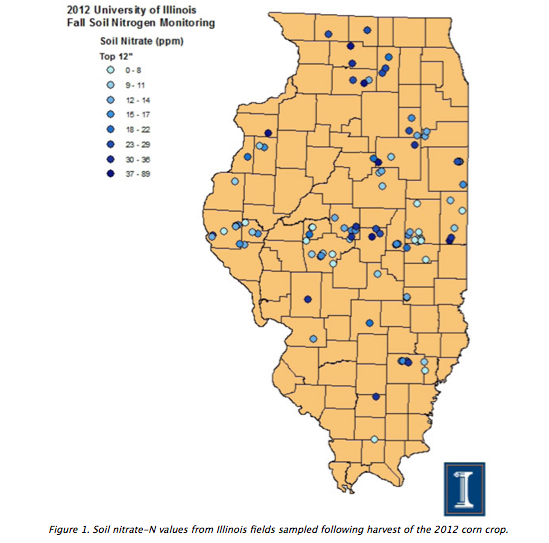
|
In October we announced a new project, funded by the Council for Best Management Practices, designed to sample soil this fall to see how much nitrogen is left after 2012's dry growing season and, in many areas, low corn yields. This is a report of what we've found so far.
There are two main reasons for doing this project. One is to see how much N is in the soil now, to help us know how much N could potentially be lost over the winter and early spring. November was relatively dry in Illinois, and so far there have been very few reports of tile lines running. Now that soils have cooled down, the nitrate-N currently present in fields will mostly likely stay in the soil unless tile lines run, in which case we can expect some of it to exit in tile drainage water.
|
For more charts and information, click here. |
The second main reason to look at soil N in the fall is to gauge the potential for some of it to be available to next year's crop, especially if you come back with corn in the same fields. It's typical for some N loss to take place if precipitation is normal from fall to early spring, but if it remains dry again like last winter, some of the N in soil now should be available for next year's crop. Knowing how much is there in the spring requires taking soil samples again in the spring, preferably close to planting.
We had a good response to our call for volunteers to take samples for this project, with about 130 sites sampled to date in the U of I portion. Cooperators were asked to take 0-to-12-inch and 12-to-24-inch samples at a single site. Samples along with some site information, including how much N had been applied in 2012 and what the yield was, were sent to a lab to be tested for both nitrate and ammonium. Both cooperators and we received the data from the lab.
Nearly all of the samples for which we have received data were taken following corn in 2012, and many were from fields where 2012 corn yields were low due to dry weather. Because we had not done such a survey in the past, we did not know how much N to expect to find, though previous sampling work had typically shown nitrate-N levels of less than 10 ppm.
Samples received were somewhat concentrated in the central part of the state, but with a good distribution there from east to west (Figure 1). Nitrate-N concentrations in the top foot ranged from near 0 to 89 ppm among the 120-plus sites reported in Figure 1. The 89 ppm was from a field in the northern part of the state; yield reported from that field was 175 bu/acre. As the only value above 50 ppm, we can consider it an "outlier."
Table 1 summarizes average N rates used, corn yields, and the nitrate-N data from the top foot of soil by region. The division of Illinois into regions was arbitrary, done using latitude of sampling sites but roughly following Illinois Route 116 and Illinois Route 16 as dividing lines.
The average N rates used and corn yields produced in sampled fields reflect the generally poor growing conditions over much of Illinois in 2012. Some of the fields in southern Illinois yielded little or nothing, while several fields in central and northern Illinois yielded from 180 to 200 bu/acre.






Post a comment
Report Abusive Comment